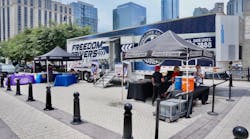Bridgestone teams with Truckers Against Trafficking to shine light on global crisis
An estimated 50 million people worldwide are exploited for commercial sex or forced labor, including thousands of women, men, girls and boys throughout the U.S. Bridgestone Americas, Inc. has partnered with Truckers Against Trafficking since 2013 to join forces in disrupting human trafficking networks and fighting such a heinous crime. Bridgestone recognizes their unique opportunity to save potential victims in ways others can’t as the “eyes and ears” of our nation’s highways.
In July, TAT hosted a Coalition Build event in partnership with Bridgestone, Pilot Company and the Tennessee Bureau of Investigation at the Bridgestone Tower in Nashville, Tennessee. The day-long summit brought transportation industry stakeholders together with law enforcement and government agencies to create stronger collaboration aimed at combatting human trafficking.
During the event, guests attended a series of private presentations, panels, and training exercises aimed at developing shared strategies to fight human trafficking nationwide. TAT also invited event participants to tour its Freedom Drivers Project mobile exhibit trailer, which provides a glimpse into the realities of domestic sex trafficking, how the trucking industry is driving change, and simple actions the public can take to fight it.
Fleet Maintenance caught up with Josh Holland, VP of Dealer Development and Mobility Solutions Deployment for Bridgestone Americas, to share some more details and ways to combat human trafficking.
Fleet Maintenance: Why is Bridgestone involved with Truckers Against Trafficking?
Josh Holland: As tire manufacturers, Bridgestone is in a unique position to close loopholes to traffickers who seek to exploit the transportation system for personal gain. Our company has a prominent voice within the commercial trucking industry, and we believe that we can utilize it to drive industry change and amplify TAT’s mission. By aligning with their initiatives, we’re able to raise awareness and educate transportation industry stakeholders and law enforcement to build a nationwide network that combats human trafficking.
We’re passionate about educating our fleet customers, commercial dealer networks and other stakeholders as to locate survivors and exploit traffickers. We want to continue our support of TAT throughout the next several years by developing innovative solutions that support the U.S. on front lines, provides educational tools for teammates and even mentorship opportunities for survivors.
FM: Why does Bridgestone think this effort will aid in reducing human trafficking?
JH: Collaboration and passion are at the heart of this partnership. Our goal in partnering with TAT is to establish an impactful and sustainable working relationship between the trucking and busing industry and law enforcement in order to combat the crime of human trafficking. Educating transportation industry professionals on the realities of this topic is crucial to saving potential victims.
This effort is also significant as it builds impactful relationships between transportation industry stakeholders, government agencies and law enforcement professionals. Everyone works together to learn and share intentional, victim-centered strategies and recommendations for preventing this crime. By bringing awareness to the problem, providing training, building relationships and providing feasible action steps, we’re able develop coordinated, effective approaches to helping victims.
FM: What are a few best practices for fleets and truck stops to educate employees to be aware?
JH: Intentionally becoming aware of your surroundings at a truck stop could save a life. During our Coalition Build with Truckers Against Trafficking, the TAT team led attendees through a series of training exercises that educated truck stop staff on “red flags” to spot in everyday trafficking scenarios. These participants were also urged to spread the word to other fleets on the road to drive awareness and build a better partnership. TAT informed and equipped our group with the tools to pay attention to trafficking in-action.
Signs of human trafficking include:
- Peculiar adult and minor interactions in secluded spaces
- Abnormal headlight flashing between drivers that seems intentional
- Unusual or secretive conversations between customers
- If a passenger vehicle pulls into the truck parking area of a rest area or truck stop and multiple people (usually females) get out of the vehicle and begin going from truck to truck
- Suspected victims that have signs of branding (tattoos, etc.), seemingly restricted or controlled communication, or make mention of meeting a quota
If these signs are present, the best practice for fleet employees to ensure a potential victim’s safety includes:
- Writing down important information that can be useful to authorities, such as detailed descriptions of the scenario and the potential trafficker’s license plate number
- Alerting the situation to the National Human Trafficking Hotline at (888)-373-7888
- Do not approach traffickers yourself. Approaching traffickers is not only dangerous for you and their victims but could lead to problems in the eventual prosecution of traffickers. Instead, contact appropriate law enforcement and allowed authorities to deal with traffickers and recover victims
Holland urged anyone that is looking to educate themselves about trafficking to visit the Truckers Against Trafficking website, where you can find training resources and additional information on what you can do to help stop human trafficking.




